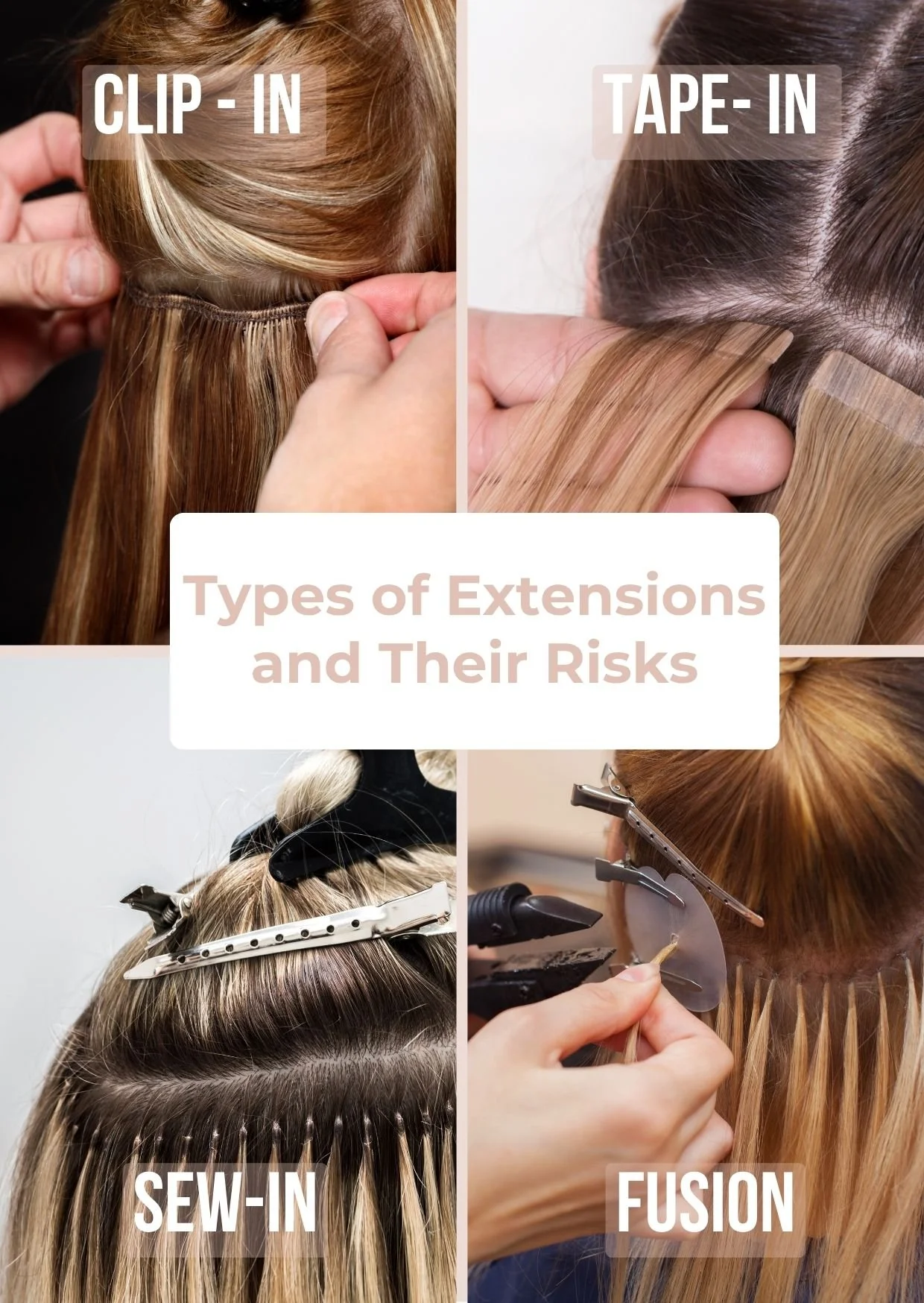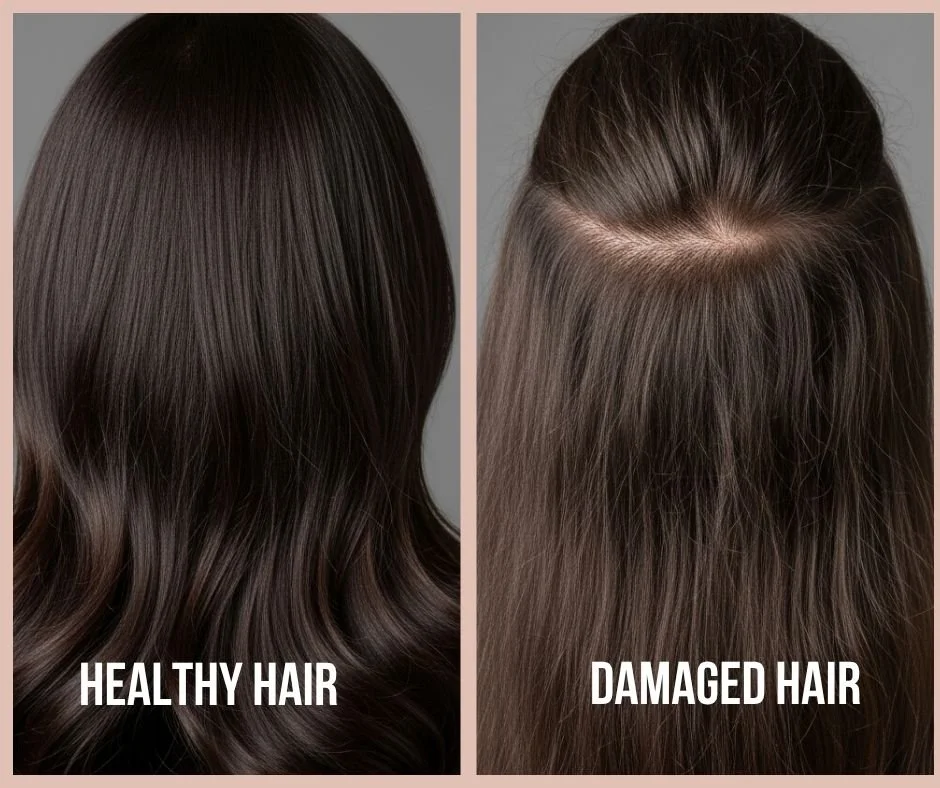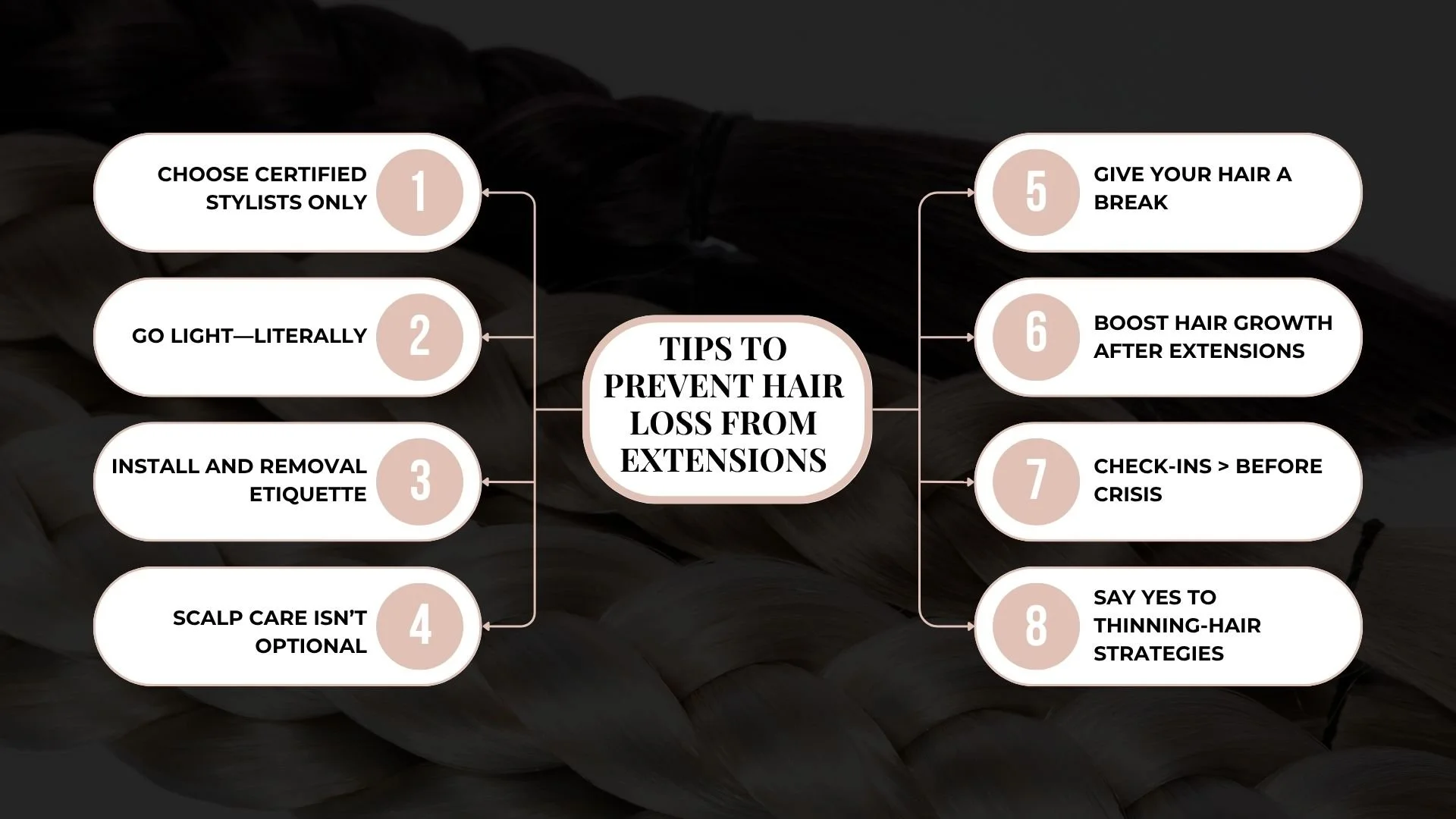Can Extensions Cause Hair Loss? Expert Advice and Tips
Can extensions cause hair loss? Oh, they absolutely can. But not the way your cousin warned you or the way that one influencer whispered between ad breaks. The damage isn’t just in the hair — it’s in the silence. The untrained hands. The eight-week “protective” installs that don’t breathe. The scalp screaming through the tension while you smile for the selfies.
You didn’t “just shed a little.” You’ve been pulled. Tugged. Pushed into styles that looked fire but left fallout in the sink and resentment in the roots—so now you’re thinking, are hair extensions bad for your hair?
But let’s be real — it’s not always the extensions. It’s the obsession with staying "put-together" at all costs. The pressure to never look like you're “letting yourself go,” even when your follicles already have.
If no one else is going to say it — we will. The truth has edges. Let’s trace them together.
What Are Hair Extensions?
You know what’s wild? A billion-dollar industry built around tiny strands of someone else’s hair—stitched, taped, or glued to your scalp—yet barely anyone talks about what happens after. We’re surrounded by influencers snapping their third “after install” selfie, but no one shows you the tension headaches, the hidden bald patches, or the regret that creeps in somewhere between week four and the emergency oil soak.
Extensions come in many flavors—clip-ins, tape-ins, weaves, keratin bonds—and depending on where you live or how deep your wallet goes, you’ve probably flirted with at least one. They’re designed to add length, bulk, density, and sometimes just a boost to get through a rough week. And when done right? No one can tell you’re not born with it. But let’s not pretend everyone’s getting a professional hair extension installation. You’ve seen it. You’ve maybe done it. The late-night YouTube DIY install that looks amazing until your scalp says “girl, no.”
But extensions aren’t just a style statement. They’re cultural. Practical. Emotional. Black and Latina women, in particular, know this isn’t just about “getting longer hair.” It’s about managing texture expectations, workplace perceptions, and sometimes, just not wanting to explain why your natural hair takes two hours to prep before 9 a.m. meetings.
Now here’s the twist no one’s bold enough to tell you upfront: can extensions cause hair loss? Absolutely. Not always immediately. Not always dramatically. But tension and trauma don’t need a drumroll. They build quietly.
The U.S. human hair extension market hit nearly $1 billion in 2024. And while that stat might impress you, here’s what should really get your attention: thousands of women are losing hair because of how badly these things are installed or maintained. What’s even more tragic? They’re not even aware it’s happening until it’s too late.
So before we talk loss, let’s get one thing straight: hair extensions aren’t evil. But the wrong technique, the wrong stylist, the wrong assumption that tight = secure? That’s where it starts to unravel.
Can Extensions Cause Hair Loss? The Science Behind It
Yes. Loudly, factually, medically: yes. But don’t just nod—let’s break it down so it actually sticks.
The condition is called traction alopecia, and it’s not some beauty-industry conspiracy theory. It’s a documented, preventable form of hair loss caused by repeated tension on the hair follicle over time. Like tight braids, overly secured weaves, glue sitting in the same spot for weeks. Eventually, the follicle taps out. And once scarring kicks in, there’s no growing it back. No serum. No tea rinse. No magic rosemary oil.
And guess what? You don’t even need to feel pain for it to start. The damage builds in silence. A little shedding here, some thinning there. Until one day, your side part doesn’t sit right and your baby hairs look more like ghost stories.
Here’s where it gets worse.
Most people think it’s about one bad install. It’s not. Can hair extensions cause alopecia? Yes—but only if they’re done carelessly and kept in past their welcome. Let’s be real: not all stylists are trained in professional hair extension installation. Some rely on brute force, sewing hair in tighter than a rent-controlled apartment lease. Others skip weight distribution checks, piling bundles onto scalps that were never meant to hold that load.
Then there’s the glue. We know someone just read this while having a bonded track that’s been in for eight weeks and counting. Adhesives—especially drugstore-grade—can clog follicles and suffocate growth at the root. Combine that with hot tools, skipped washes, and zero scalp care, and we’re not looking at glam anymore—we’re looking at damaged hair from extensions that might not recover.
Let’s not ignore thin or fragile hair, either. So, are hair extensions bad for thin hair? If they’re heavy, absolutely. If they’re improperly placed, without regard to tension zones or density support? It’s a one-way ticket to fallout.
Dr. Crystal Aguh, a board-certified dermatologist and hair loss researcher, states:
“Traction alopecia is disproportionately underdiagnosed in women of color, even though it’s one of the most common causes of preventable hair loss. Prevention, in this case, isn’t optional—it’s critical.”
There’s also the maintenance—or lack of it. Sleeping in extensions for weeks with no scalp care or proper cleansing routine leads to matting, inflammation, and bacterial irritation. You wouldn’t wear a face full of foundation for three weeks straight. Why treat your scalp worse?
So yes, can extensions cause hair loss? And can hair extensions cause alopecia?
Both—undeniably. The fault lies in bad practice, not the concept. When done right by a trained professional, with tension calibration, regular maintenance, and actual regard for your natural hair’s condition—extensions can be safe.
But if your install is giving blood flow restriction and no one’s even asking you about how your scalp feels two weeks in? That’s not glam. That’s negligence.
Types of Extensions and Their Risks
Let’s break it down—because not all extensions are the same (and some are secretly more harmful than a dumpster fire). Your choice matters.
Clip‑ins
Clip‑ins are the lightweights—literally. You snap them in, wear them, and clip them out before bed. Risk factor is minimal—unless you sleep in them, which is an “oops, not cute” moment waiting to happen. For thin or fragile hair, they’re often the safest pick, avoiding constant tension.
Risks vs. benefits: Nearly zero risk, but zero longevity. Great for short-term glam with low stakes.
Tape‑ins
These involve sandwiching your hair between two adhesive strips. Yes, it looks seamless—but tension builds fast if they’re layered too close to the scalp or left beyond 6 weeks. Dermatologists caution heavy or multiple tape-ins can trigger tension-related shedding.
Sew‑ins/weaves
Here’s where it gets dicey: cornrow braids, then wefts sewn on. These pack serious weight on a small base—meaning every pull adds up. “Glue-in in America”—a.k.a sew-ins—often cause more tension than bonded extensions and are flagged by the AAD as major traction‑alopecia triggers.
Bonded/Fusion (Keratin/Glue)
These extensions are micro-glued strand by strand. Slick on the surface, brutal beneath. Heat activates the bond—which is fine—unless it's overdone. Pro stylists warn glue can suffocate follicles and cause damage over time, and that improper removal means breakage that’s forever.
Quick Comparison:
Clip‑ins: Low tension, user-controlled. Best for thin hair.
Tape‑ins: Medium tension, adhesive risks. Requires mid‑install checks.
Sew‑ins: High tension, high tension, high tension—frequent installs + heavy wefts = risky.
Bonded: Scalp smarts required—if heat/detachment isn’t managed, enjoy fallout.
Signs of Hair Damage from Extensions
You took extensions out and expected bounce. Instead, you got fallout. Then came the panic. Here’s what to watch for before it’s irreversible.
Scalp irritation & inflammation
Itching? Redness? Pain? That’s scalp distress—often an early red flag of tension pulling, micro-tears, or adhesive clog. Experts at Treatment Rooms London report constant pulling or glue buildup can cause inflammation that leads to hair loss if ignored.
Thinning patches and breakage
You might notice a wider part or sparse temples. That’s traction alopecia silently striking. Up to 15% more women sought treatment after glue/extension damage in recent years. And Reddit users have shared their long-term horror—thin, brittle hair that never really came back.
Excessive shedding post-install
It’s normal to lose about 100 strands daily. But if that hair is clinging to your extensions every time you brush? That’s more than normal—it’s alarming. PHE Salon notes that early intervention can reverse this trend, but only if you act.
Damage hair after extensions taken out
That felt moment when you see your scalp too clearly? That’s not your imagination. Experts confirm poor techniques or late removal often leave the hair weighed down and traumatized. Low-density hair is especially vulnerable, and that overhanging weight strips volume fast.
When to see a pro
If you spot patches, persistent shedding, inflammation, or pain beyond a few days—book time with a trichologist or dermatologist. Early-stage traction alopecia is reversible, but scarring alopecia isn’t. If you delay, you risk permanent damage.
Tips to Prevent Hair Loss from Extensions
Yes, you can have extensions and healthy roots. Your hair can grow after extensions—if you do things smarter than your ex did. Here’s how to live your best, hair-safe life:
1. Choose certified stylists only
Always prioritize a trained pro who offers professional hair extension installation. They know scalp mapping, load distribution, and safe tension levels. If your stylist skips that? Walk.
2. Go light—literally
Use lightweight, human-hair strands. Clip‑ins are most forgiving. For tape-ins or bonds, ask for thin pieces or micro-extensions. Thin hair users should leave a ¼" buffer from the scalp to reduce stress.
3. Install and removal etiquette
Never try DIY. Even micro-beads, sew-ins, bonds—they all need professional removal. Ripping them out = ripping natural hair with them. Stuck glue? Let a pro handle it.
4. Scalp care isn’t optional
Wash and condition gently every 7–10 days. Use sulfate-free products and detangle from root to tip to avoid matting and stress. Rotate gentle scalp treatments—cilia-bristle brushes, caffeine serums, niacinamide formulas—to support circulation and follicle vitality.
5. Give your hair a break
After 2-3 months of extensions, unplug. Treat your natural hair to a 4–6 week rest. Let follicles breathe, restore, rebuild. Rotate zones to avoid overloading the same scalp sections.
6. Boost hair growth after extensions
Biotin supplements, topical minoxidil, and scalp massages can help regrow or reinforce – but they’re not magic. Scalp massages, even with a $10 silicone brush, stimulate circulation—just like Molly‑Mae demonstrated. Consistency is key. Combined with breaks, growth supplements, and a nutrient-rich diet, you’re giving your strands the best shot at recovery.
7. Check-ins > before crisis
Monthly check-ins? Yes. Your scalp changes. Your hair grows. What felt fine last month might feel tight now. A pro review early can redirect tension and save edges.
8. Say yes to thinning-hair strategies
For fine or fragile hair, ask about Veila Pull-Thru or micro-link installs—they avoid glue, reduce weight, and support healthy wear. Clip‑ins? Never sleeping in them. Tape‑ins? Never past 6 weeks.
Conclusion
Extensions aren’t the enemy. The misuse of extensions is. With smart choices, smart removal, and smart care, your hair can shine and grow. The Glam House—your hair salon in Denver—is ready to guide you through every step of safe extension wear. You can have impact, volume, confidence—and healthy roots. Let’s talk real about what’s really going on up there.
Frequently Asked Questions
-
A: Yes—if you catch it early. Hair loss from extensions, especially from traction, can be reversed when tension is removed and follicles are still active. But if scarring alopecia sets in, regrowth is unlikely. Acting fast with professional help is key.
-
A: Start by removing the extensions professionally—no yanking, no shortcuts. Then nourish your scalp, avoid tension, and use gentle cleansers. If shedding persists beyond a few weeks, consult a trichologist.
-
A: They can, especially if installed too tightly, worn too long, or used on already thin hair. Extensions don’t cause thinning on their own, but poor practices around them absolutely will.
READ MORE…
Do Hair Extensions Ruin Your Hair? The Ultimate Guide to Safe Use




